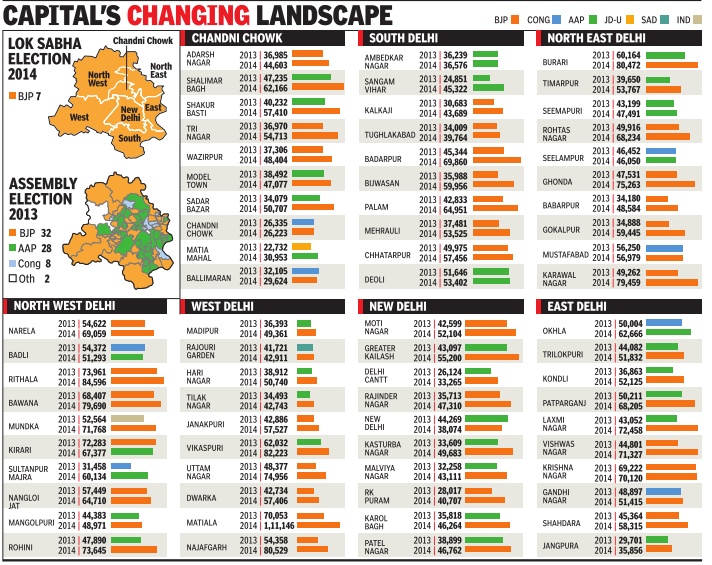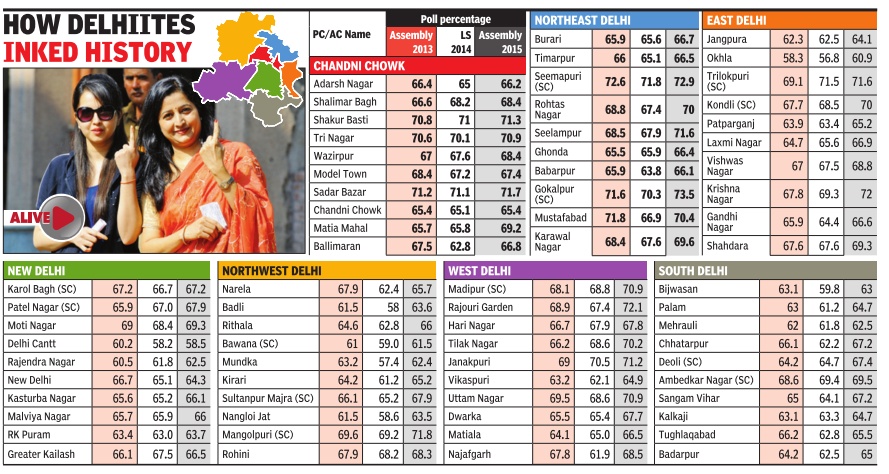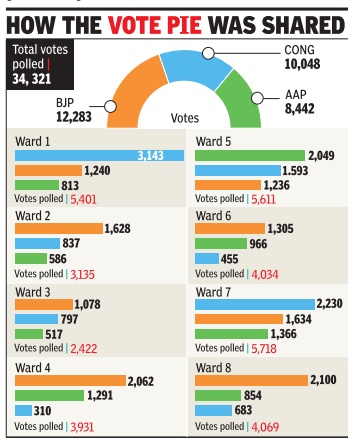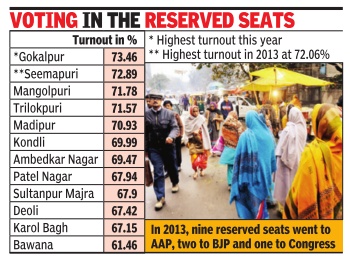Delhi: Assembly elections
(→1993-2014: Shifting political loyalties) |
(→1993-2014: Shifting political loyalties) |
||
| Line 10: | Line 10: | ||
=1993-2014: Shifting political loyalties= | =1993-2014: Shifting political loyalties= | ||
| − | [[File: 1993-2014 Shifting political loyalties.jpg|1993-2014: Shifting political loyalties in Delhi city |frame|500px]] | + | [[File: 1993-2014 Shifting political loyalties.jpg|1993-2014: Shifting political loyalties in Delhi city. Graphic [http://epaperbeta.timesofindia.com//Article.aspx?eid=31808&articlexml=Vote-pattern-How-Delhi-has-been-the-sultan-08022015006058 ''The Times of India''] |frame|500px]] |
[[File: Delhi turnout 2013 15.jpg|Delhi: percentage of voters who cast their vote in 2013, 2014, 2015 |frame|500px]] | [[File: Delhi turnout 2013 15.jpg|Delhi: percentage of voters who cast their vote in 2013, 2014, 2015 |frame|500px]] | ||
| + | |||
''' Vote pattern: How Delhi has been the sultan of swing ''' | ''' Vote pattern: How Delhi has been the sultan of swing ''' | ||
Revision as of 01:33, 15 February 2015
This is a collection of articles archived for the excellence of their content. |
Contents[hide] |
1993-2014: Shifting political loyalties

Vote pattern: How Delhi has been the sultan of swing
Subodh Varma The Times of India
Between 1993 and 2014 Delhi voted for 16 times . That's an election almost every 16 months.Starting 1993, there've been six Assembly elections (1993, 1998, 2003, 2008, 2013 and 2015), six LS polls (1996, 1998, 1999, 2004, 2009 and 2014) and four civic elections (1997, 2002, 2007 and 2012).
A look at the vote shares of parties over these 16 elections shows a seeming unpredictability and a tendency to flip parties. This isn't evident if you look at only one type of election, say assembly or corporation. Put all elections together and it shows.There's a desire to change, perhaps even to punish. Hubris doesn't go down well with Delhi, especially if it accompanies non-performance.In this heavily politicized city, the educated and young electorate makes the distinction between requirements of different levels of government.
Between 1993 and 1998, voters gave a long rope to the rising BJP . They won the first 1993 assembly election, got majority votes in 1996 LS, won the 1997 corporation and majority in the 1998 LS polls which saw the shortlived NDA government emerge at the center.
Then, something snapped.After giving over 50% votes to BJP in the February 1998 LS elections, Delhi switched. The same November, it defeated BJP in the state elections, giving Shiela Dixit-led Congress their first government.
Months later, in 1999, Del hi again voted BJP in the LS elections. Vajpayee formed government at the Center.Three years later, in the 2002 civic polls, Delhiites defeated BJP and brought Congress.Next year, they again voted Congress in the assembly .Then, in the 2004 LS polls, the Capital went with Congress, giving them over 55% votes.
Three years later, Delhi tired of Congress and voted BJP back into the corporation. But in the 2008 assembly, Congress won a record third time. The Congress honeymoon continued in the 2009 LS elections, the party getting 57% votes. It took three years for another switch to happen--BJP won the 2012 civic polls.
This switching around might seem fickle. Actually , it's a flailing between the two options available. In a two horse race, Delhi-wallahs exercised the whip to punish non-performance. Finally , in 2013, hubris met its nemesis. The two dominant parties that had, between them, ruled Delhi at all levels for two decades faced a challenger, Aam Aadmi Party .BJP , which was again rising, had expected a rebound from the moribund Congress but AAP walked away with over 29% votes and Congress dipped to its all-time low of 25% vote share in the Assembly elections.
Knowing that AAP wasn't a serious contender for the Centre, and tired of Congress, Delhi voted BJP in 2014 LS, giving it 46% votes. AAP increased its vote to 33%. Congress plummeted to an alltime low of 15%.
2013-14

See graphic
Delhi cantonment board elections: 2015
Jan 13 2015
Risha Chitlangia
BJP's strong performance in the Delhi Cantonment Board poll and a sharp decline in Aam Aadmi Party votes is a morale booster for the party ahead of the much more challenging task of winning the assembly polls scheduled for February 7. With BJP-backed candidates winning five out of eight wards, the party is keen to read the result as an indication of polls winds in the capital with Prime Minister Narendra Modi having launched the saffron campaign with a rally on Saturday , a day before polling for the cantonment board.
Though the board election is modest in terms of the electorate and BJP won a seat less than earlier, there are reasons for satisfaction. AAP's failure to revive its fortunes after scoring a blank in the LS election and Congress's relatively better performance plays to BJP's advantage.
The increase in Congress's vote share comes at AAP's expense and the trend augurs well for BJP that would prefer a three-way fight in assembly polls rather than a more direct one-to-one face off with AAP and its convenor Arvind Kejriwal.
The results also indicate that the party continues to en joy middle class support-the can tonment area has a sizable population of this segment while Congress neutralized AAP's impact with Kejriwal's outfit registering a 15% dip in its votes, down to 25% from 40% in the assembly elections. “This has once again proved that BJP is the first choice of Delhiites. The voters of the cantonment board have shown that they do not believe in fractured mandate,“ said Satish Upadhyay , Delhi BJP chief. Though BJP had staged a recovery in the LS election, the results were read as the result of a Modi wave and the party was aware that in 2013 AAP's commando Surender Singh defeated four-time BJP strongman Karan Singh Tanwar by 300-odd votes. AAP finished third in four wards and most of its candidates lost by a large margin.
With the party having tak en a calculated gamble in not projecting a CM candidate in a highly urbanized state, evidence that Modi's appeal with the middle class and “urban“ villages has not waned will increase the confidence levels in the BJP and embolden party chief Amit Shah to adopt a tough yardstick in selecting Assembly candidates.
Despite being routed by AAP and BJP in 2013, Congress managed to retain two wards and pushed AAP to third position. This helps Congress argue that it is the alternate to BJP and that AAP is fading. Congress has got 10,048 votes to AAP's 8,442 votes but the difference helped Congress climb the rankings. BJP, which lost in three wards, finished second in two.
AAP finished third in four wards and most of its candidates lost by a large margin.But AAP members do not see this as reflecting the broader mood in the city . “This doesn't reflect the public mood. This is a small area. Moreover, we are contesting for the first time. We have managed to win in BJP's stronghold,“ said Surender Singh.
The result has revived Congress' hope that it will not be washed out again. “The gap in the vote share between BJP and AAP, and Congress emerging as second shows the ground situation is changing.It is not a two-way contest,“ said Arvinder Singh, DPCC chief.
2015: The campaign
Delhi assembly elections 2015: An acerbic campaign where no one was spared
PTI | Feb 6, 2015 PTI
A look-back at the Delhi poll campaign reflects how the war of words among different contestants and parties unfolded one of the fiercest and bitter election narratives of recent times.
Prime Minister Narendra Modi set the tone for the election battle by making a veiled reference to Arvind Kejriwal as an "anarchist" in the first BJP rally at Ramlila Maidan.
"We need development here, not anarchy. They are good at dharnas. We are good at running government," the Prime Minister said.
After Kiran Bedi decided to make her political debut by joining the BJP, Congress came down hard on her terming it as "gross political opportunism".
Arvind Kejriwal welcomed his former comrades in arms with a politically correct tweet saying "I have been fond of Kiran Bediji. I always tried to convince her that she should join politics. I am happy she did it today".
However, the AAP niceties disappeared as soon as Shazia Ilmi followed Bedi and the verbal slugfest broke loose.
Ashutosh called Bedi's move of joining BJP as an "iconic political somersault and opportunism on her behalf".
The party dug out old tweets of both the former India Against Corruption members, the ones in which they had previously criticized Narendra Modi.
"One day, Namo (Narendra Modi) will have to respond with clarity about riot massacre," a tweet posted by Bedi on March 16, 2013.
AAP went on to say that Bedi was "parachuted" into BJP which can make her a "scapegoat" in case the party lost the elections.
"Bedi is a scapegoat ... Vijay Goel, Satish Upadhyay, Harsh Vardhan are plotting against her," Kejriwal said.
Kiran Bedi hit out at Kejriwal terming him as a "toxic" influence and his twitter account "polluting".
"His company is toxic. I felt it to an extent even when I was with him, but we had a common goal that the country must rid itself of scams and corruption," Bedi said.
In a tweet, she said, "I blocked him (Kejriwal) 15 months back when he called himself an anarchist. He was spreading negativity. Didn't want my four million followers to see negativity ... it was a polluting account".
As the controversy surrounding AAP's election funding erupted, a new saga of mudslinging was witnessed.
Shazia Ilmi dubbed the Rs 2 crore donation to the Aam Admi Party as "hawala at midnight".
"They talk about an internal Lokpal. But no one worries of checking donations of Rs 2 crore. Kejriwal is hiding behind a false image of honesty and trying to fool people," Ilmi said.
Amit Shah also attacked AAP extensively on the controversy at the election rallies with catchy alliteration.
"Kali raat me kala dhan lene wali party kali rajneeti hi kar sakti hai (Party which takes black money in the darkness of the night can only indulge in black politics)," Shah said at a rally on February 4.
A day later at another rally, he said, "Kali raat me aane wala dhan kala dhan hi hota hai (money which comes in the dark of the night is black money)".
Miffed at not getting an invitation to watch the Republic Day parade, Kejriwal also created a furore and Bedi came down heavily on the AAP chief.
"I think he is playing sob sob. I think he must grow up. Invitations come not when you desire. They come by something else but they are never demanded, they come by rules and regulations, by protocols whatever it is," Bedi said. AAP accused that the cameras were focusing a little more on Bedi who was seated in the front rows watching the parade.
"It is for the country to see what is being done. How a sacred occasion like the Republic Day is being politicized. the camera was focusing a little extra on her," senior AAP leader Yogendra Yadav said.
The Prime Minister switched into election gear after hosting President Obama on Republic Day and accused AAP of "backstabbing" Delhi voters.
"The very people whom you voted for last time stabbed in your back. They shattered your dreams and destroyed Delhi. You gave them a befitting punishment in Lok Sabha polls. People do not repeat their mistakes again and again," Modi said at an election rally.
Highest voter turnout of 73.46%; Development issue still unaddressed Gokalpur has never repeated MLAs
Ambika Pandit
Feb 09 2015
Development is yet to touch most lives in the densely populated constituency of Gokalpur, which is a cluster of 45 unauthorized colonies and a resettlement colony. However, this seat, one of the 12 reserved SC constituencies, recorded the highest voter turnout of 73.46%. Of the 1.94 lakh voters, about 90,000 (46%) are from scheduled sub-castes like Khatik, Mallaha, Koli and Valmiki and their votes decide the winner.
It is not just the highest turnout that sets this constituency apart, but also the fact that the constituents here have voted for change every election and not repeated an MLA.
None of its elected representatives in the past 22 years have managed to retain their seat. In December 2013 polls, Gokalpur was one of the top performers registering a voter turnout of 70.88%. Nine of 12 reserved constituencies rejected Congress and chose AAP, but this was one of the two seats which chose a BJP candidate.
Many here are not surprised by the high turnout as this election was a high pro file one considering the fact that three ex-MLAs and the daughter of an ex-MLA were in the fray.
Intense mobilization by all candidates in the assembly with a dominant Dalit vote base seems to have brought out more voters than ever before. Also, residents here are restless with pressing development issues remaining unaddressed for decades.
Residents here feel the pinch of not having a government hospital to cater to the needs of the poor and low income group families.
Schools are few and sewers have only started coming to some areas. The vote this time, thus, is probably seen as yet another attempt by residents to bring their plight into focus.
The February 10 verdict will be a test for the entire heavyweight line-up, which includes AAP’s Fateh Singh, who was BJP’s MLA from 1993 to 1998, BSP’s former MLA Surender Kumar, and Ranjeet Kashyap who was the 2013 legislator from BJP.
Congress, which hasn’t won Gokalpur since 2003, fielded Rinku, municipal councillor from Nand Nagri ward of the neighbouring Seemapuri assembly constituency.
Even though Rinku is not a household name in Delhi politics, she is no stranger to Gokalpur being Roop Chand’s daughter.
Chand, the MLA from Gokalpur between 1998 and 2003, wrote the book, ‘Dr BR Ambedkar: Neither a Freedom Fighter nor the Architect of the Constitution’, which turned many voters and Dalit groups against him. But this time Congress fielded her in the assembly election dismissing the controversy as a non-issue and projecting her as an honest and the right choice for the seat.


